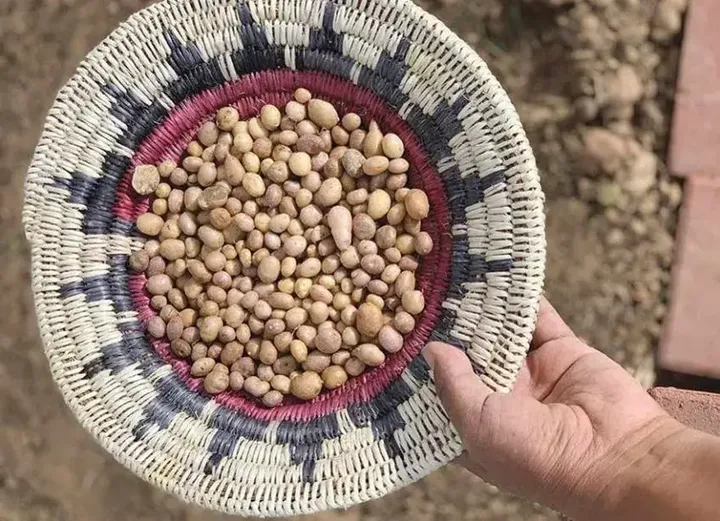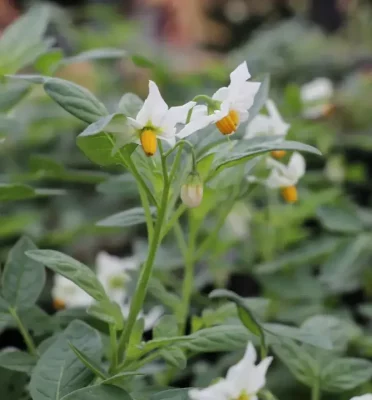
A Fourth Sister? What New Research Suggests About Indigenous Life and Agriculture
Community
Squash, beans, maize. For thousands of years, these crops have been enshrined in the spirituality and agriculture of Indigenous tribes across the American Southwest. Known as the “Three Sisters,” they have been grown together in a sophisticated, sustainable method of farming for thousands of years. Despite this history, the practice was almost completely erased in the face of devastating colonization. Reintroduction has come from the tireless efforts of Indigenous people and their allies, restoring the Three Sisters to their rightful place as a source of life and culture.
Now, new research from The Natural History Museum of Utah (NHMU) suggests the existence of a lost fourth sister: the Four Corners potato. The study, published in July in the American Journal of Botany, was performed by a team of researchers including Bruce Pavlik, former director of conservation at Red Butte Garden, and Lisbeth Louderback, curator of archaeology at the NHMU and associate professor of anthropology at the University of Utah. Their results indicated that Solanum jamesii (more commonly known as the Four Corners potato) was traded and grown by multiple tribes across centuries and hundreds of miles.
It all started with Louderback’s dissertation research at an archaeological site in Escalante Valley called North Creek Shelter. While examining ancient artifacts, the team identified what looked like potato starch granules. Their research indicated that these were over 10,000 years old. Turning to the historical record, they found a document from a Mormon cavalry that referred to the region as “Potato Valley,” indicating that the starch came from a native plant, rather than the South American import found in a typical supermarket aisle. It came from the Four Corners potato—a tiny, hardy spud that is drought, disease and frost resistant.
“We are calling the Four Corners potato the ‘Lost Sister’ or the ‘Fourth Sister’ along with beans, corn and squash to elevate the idea that this plant was very significant, not only in food, but in ceremony and medicinal use.”
A few years following the initial starch discovery, the team found a live population of the Four Corners potato only about 100 meters away from the archaeological site at North Creek Shelter. Referring back to the historical record, Pavlik and Louderback realized that the Four Corners potato had been located at or near many archaeological sites across the southwest region. So, they partnered with the US Potato Genebank and the National Science Foundation to survey vast swathes of land in each of the Four Corners States (Utah, Colorado, New Mexico and Arizona) over the course of about three years. Randomly sampling both archaeologically-associated and wild sites, they collected over 600 leaf samples to genetically analyze.

From interviews with living descendants of Native American tribes in the region—including the modern Pueblo, Diné, Southern Paiute and Apache tribes, among others—Pavlik and Louderback were also able to learn about how the Four Corners potato was used. “There are different ways that they would process it,” says Louderback. “Some would eat it raw, some would grind it, some would boil it in a pot and add white clay to reduce the bitterness. Some of the tribes today still grow them in their garden, or at least have memories of their grandparents growing them, collecting them, cooking them.”
“They understood the relationship between plants like the potato and plants like corn,” says Pavlik. “They were growing and selecting sites for growing based on a knowledge of climatic patterns in the desert Southwest, and particularly patterns associated with the monsoon … All of that is sophisticated.” In fact, the Four Corners potato itself could be considered a miracle crop. “We are calling the Four Corners potato the ‘Lost Sister’ or the ‘Fourth Sister’ along with beans, corn and squash to elevate the idea that this plant was very significant, not only in food, but in ceremony and medicinal use,” says Pavlik. “That actually has some basis in Western science as some of these glycoalkaloid compounds that can be extracted from the tubers are known to be anti-cancer drugs.” The Indigenous farmers of the past recognized the spud’s properties and utilized them in ways that could be beneficial in the present.
“It’s an example of how these food practices have survived … Some of those potato populations only exist because they were managed and cared for by Indigenous populations long ago.”
Speaking on past practices and how they may be applied today, Louderback says, “I think that’s why we were so successful in developing partnerships with Indigenous communities and farmers; they really have a deep interest in revitalizing this potato and reclaiming it as part of their heritage and cultural identity.” For instance, the tribal interviews were conducted by Cynthia Wilson, an Indigenous advocate and member of the Diné who has spearheaded the Four Corners potato as a potential solution to some of the food insecurities faced by Indigenous people currently. The crop may be key to Indigenous food sovereignty, in spite of generational oppression and climate change.
“Since our research and our partnerships with a lot of the Indigenous communities, there’s been kind of a resurgence of growing this potato again in their family gardens and cultivating it,” says Louderback. “There are also other uses—ceremonial and ritual—and those uses are still in practice today, especially with the Diné and some of the Puebloan tribes.”
Indeed, the extensive use and cultivation of the crop prior to European settlement suggests the spud may be in a similar situation as the Three Sisters—suppressed but significant, on the brink of growing back. “Our work with the Four Corners potato is kind of a connection to that long history, and we’re talking thousands and thousands of years” says Louderback. “It’s an example of how these food practices have survived … Some of those potato populations only exist because they were managed and cared for by Indigenous populations long ago.”
The research pushes forward the NHMU’s mission to preserve Utah’s archaeological marvels and bring them into the current day. Indeed, the researchers hope to continue their analysis and examine if the Four Corners potato may have been genetically domesticated. As for now, the study highlights our state’s shared history and the triumphs of Indigenous people both in the past and the present. “It’s an ancient food, but here it’s being revitalized and brought back to life,” says Louderback.
To learn more about this research and how the NHMU is investigating Utah’s natural and cultural landscapes, read the original study in the American Journal of Botany or check out NHMU’s own article about this spud-tacular potato. Support the preservation and restoration of Indigenous food culture by engaging with The Traditional Foods Program, which was founded by Cynthia Wilson and works directly with tribes living near Bears Ears National Monument.
Read more about SLC’s Indigenous communities:
The Story of Three Sister’s:A Celebration of Indigenous Foodways
The Art of Belonging: How Food Transcends Cultures to Create Identity